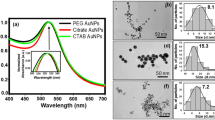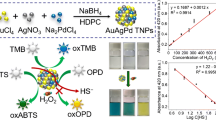Abstract
Artificial inorganic peroxidase is of great interest due to its intrinsic advantages over natural counterpart. Negatively charged gold nanoparticles (AuNPs) were discovered to function like a peroxidase in the present study. Two AuNPs in different size were prepared and characterized by TEM, and assayed for peroxidase activity. Its catalytic activity was found to follow Michaelis–Menten kinetics. The negative surface charge notably improves the affinity toward a substrate TMB, proved by the determined kinetic parameters. The particles expressed optimal catalytic activity under mildly acidic environment and resistance to elevated temperature and increased concentration of sodium azide. The origin of the activity was investigated tentatively. Hydrogen peroxide-treated AuNPs exhibited an enhanced activity. EDTA temporarily blocked the activity partially, while thiol groups permanently blocked the activity completely. Tests imply that it is the surface Au+ that provides the activity. The successful oxidation of dopamine, as an instance, under the action of AuNPs as a peroxidase was conducted. These studies would lead to a wide range of potential applications.






Similar content being viewed by others
References
Saha K, Agasti SS, Kim C et al (2012) Gold nanoparticles in chemical and biological sensing. Chem Rev 112:2379–2739
Louis C, Pluchery O (2012) Gold nanoparticles for physics, chemistry, and biology. Imperial College Press, London
Sardar R, Funston AM, Mulvaney P et al (2009) Gold nanoparticles: past, present, and future. Langmuir 25:13840–13851
Bunz UHF, Rotello VM (2010) Gold Nanoparticle–fluorophore complexes: sensitive and siscerning “noses” for biosystems sensing. Angew Chem Int Ed 49:3268–3279
Liu J, Guan Z, Lv Z et al (2014) Improving sensitivity of gold nanoparticle based fluorescence quenching and colorimetric aptasensor by using water resuspended gold nanoparticles. Biosens Bioelectron 52:265–270
Jain KK (2012) The Handbook of Nanomedicine. Springer, New York Heidelberg Dordrecht London
Jia F, Liu X, Li L et al (2013) Multifunctional nanoparticles for targeted delivery of immune activating and cancer therapeutic agents. J Control Release 172:1020–1034
Mieszawska AJ, Mulder WJM, Fayad ZA et al (2013) Multifunctional gold nanoparticles for diagnosis and therapy of disease. Mol Pharm 10:831–847
Ansar SM, Perera GS, Ameer FS et al (2013) Desulfurization of mercaptobenzimidazole and thioguanine on gold nanoparticles using sodium borohydride in water at room temperature. J Phys Chem C 137:13722–13729
Liu X, He L, Liu Y-M et al (2014) Supported gold catalysis: from small molecule activation to green chemical synthesis. Acc Chem Res 47:793–804
Biswas S, Sengupta S, Roy Chowdhury S et al (2014) CXCL13-CXCR5 co-expression regulates epithelial to mesenchymal transition of breast cancer cells during lymph node metastasis. Breast Cancer Res Treat 143:265–276
Li Y, Schluesener HJ, Xu S (2010) Gold nanoparticle-based biosensors. Gold Bulletin 43:29–41
Lan D, Li B, Zhang Z (2008) Chemiluminescence flow biosensor for glucose based on gold nanoparticle-enhanced activities of glucose oxidase and horseradish peroxidase. Biosen Bioelectron 24:940–944
Gao L, Zhuang J, Nie L et al (2007) Intrinsic peroxidase-like activity of ferromagnetic nanoparticles. Nat Nanotech 2:577–583
Yu F, Huang Y, Cole AJ et al (2009) The artificial peroxidase activity of magnetic iron oxide nanoparticles and its application to glucose detection. Biomaterials 30:4716–4722
Liu Y, Yu F (2011) Substrate-specific modifications on magnetic iron oxide nanoparticles as an artificial peroxidase for improving sensitivity in glucose detection. Nanotechnology 22:145704–145711
Zuo X, Peng C, Huang Q et al (2009) Design of a carbon nanotube/magnetic nanoparticle-based peroxidase-like nanocomplex and its application for highly efficient catalytic oxidation of phenols. Nano Res 2:617–623
Jv Y, Li B, Cao R (2010) Positively-charged gold nanoparticles as peroxidiase mimic and their application in hydrogen peroxide and glucose detection. Chem Commun 46:8017–8019
Brown KR, Fox AP, Natan MJ (1996) Morphology-dependent electrochemistry of cytochrome c at Au Colloid-Modified SnO2 Electrodes. J Am Chem Soc 118:1154–1157
Storhoff JJ, Lazarides AA, Mucic RC et al (2000) What controls the optical properties of DNA-linked gold nanoparticle assemblies? J Am Chem Soc 122:4640–4650
Park JW, Shumaker-Parry JS (2014) Structural study of citrate layers on gold nanoparticles: role of intermolecular interactions in stabilizing nanoparticles. J Am Chem Soc 136:1907–1921
Bally RW, Gribnau TCJ (1989) Some aspects of the chromogen 3,3′,5,5′-tetramethylbenzidine as hydrogen donor in a horseradish peroxidase assay. J Clin Chem Clin Biochem 27:791–796
Karasyova EI, Losev YuP, Metelitza DI (2002) Peroxidase-catalyzed oxidation of 3, 3′, 5, 5′-tetramethylbenzidine in the presence of 2,4-dinitrosoresorcinol and polydisulfide derivatives of resorcinol and 2,4-dinitrosoresorcinol. Russ J Bioorg Chem 28:128–135
Napolitano A, Crescenzi O, Pezzella A et al (1995) Generation of the neurotoxin 6-hydroxydopamine by peroxidase/H2O2 oxidation of dopamine. J Med Chem 38:917–922
Sandroff CJ, Herschbach DR (1985) Kinetics of displacement and charge transfer reactions probed by SERS: evidence for distinct donor and acceptor sites on colloidal gold surfaces. Langmuir 1:131–135
Cortie MB, Lingen EVD (2002) Catalytic gold nano-particles. Mater Forum 26:1–14
Badia A, Cuccia L, Demers L et al (1997) Structure and dynamics in alkanethiolate monolayers self-assembled on gold nanoparticles: a DSC, FT-IR, and deuterium NMR study. J Am Chem Soc 119:2682–2692
Pandey P, Singh SP, Arya SK et al (2007) Application of thiolated gold nanoparticles for the enhancement of glucose oxidase activity. Langmuir 23:3333–3337
Mackey MA, Saira F, Mahmoud MA et al (2013) Inducing cancer cell death by targeting its nucleus: solid gold nanospheres versus hollow gold nanocages. Bioconjug Chem 24:897–906
Acknowledgements
This research was supported by the National Natural Science Foundation of China (Grant No. 21071114), as well as by the Excellent Program of Activity of Science and Technology for Overseas-Returned Scientists founded by the Ministry of Human Resources and Social Security of the People’s Republic of China, by the Key Natural Science Foundation of Hubei Province (2012FFA100), the Program for Innovative Research Team of Outstanding Youth of Universities in Hubei Province, and by Hubei Collaborative Innovation Center for Catalysis Materials.
Author information
Authors and Affiliations
Corresponding author
Rights and permissions
About this article
Cite this article
Liu, Y., Wang, C., Cai, N. et al. Negatively charged gold nanoparticles as an intrinsic peroxidase mimic and their applications in the oxidation of dopamine. J Mater Sci 49, 7143–7150 (2014). https://doi.org/10.1007/s10853-014-8422-x
Received:
Accepted:
Published:
Issue Date:
DOI: https://doi.org/10.1007/s10853-014-8422-x




